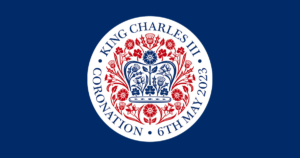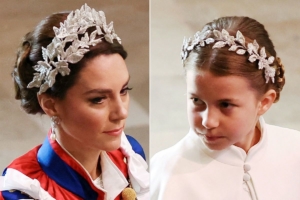What I Learned from King Charles’ Coronation
by Paula Gail Benson

Last weekend, I was able to spend a little time watching and listening to the King’s coronation while preparing for and driving to attend a young friend’s college graduation. I wish that I had tuned into the broadcast earlier to see the pageantry of the carriages processing to Westminster Abbey. I very much enjoyed the King’s entrance into the Abbey attended by his honorary pages, including his grandson, Prince George. I also found it very endearing to hear Prince William pledge allegiance as the King’s “liege man” followed by a kiss on the King’s cheek.
I found two websites that were particularly helpful in describing the coronation weekend. First, the Coronation of Their Majesties The King and Queen Camilla, provided information about the schedule (the coronation to take place on Saturday, May 6; a concert to be held on Sunday, May 7; and a bank holiday on Monday, May 8, to be known as the Big Help Out, when people were encouraged to volunteer with charities and local organizations). Throughout the long weekend, Coronation Big Lunches were to take place in communities throughout the United Kingdom. The website offered suggested recipes along with short films, coloring books, and activities provided for children.
Second, the Royal Family’s website contained the Coronation Service, the official Coronation portraits, and photos of members of the Royal Family participating in the Big Lunches and Big Help Out. The website also contained detailed information about the music, vestments, flowers, and regalia at the event.

My attention was drawn to the headpieces worn by Princess Catherine and Princess Charlotte. One article called them “diadems.” To me, they looked like jeweled laurel wreaths. In “The Deeper Meaning Behind Princess Charlotte and Princess Kate’s Matching Silver Flower Crowns,” Elise Taylor, a writer for Vogue, described Princess Charlotte’s as a “delicate silver bullion and crystal flower crown by Jess Collet and Alexander McQueen,” and saying it matched that of her mother. According to Taylor, “The jewelry design is seemingly a nod to a motif used throughout Charles’s coronation of the Green Man. An ancient figure from British folklore, the Green Man symbolizes spring and rebirth. He wears a crown of oak, ivy, and hawthorn, and the emblematic flowers.”
Alexander McQueen designed the white dresses worn by Princess Catherine and Princess Charlotte to the Coronation. The gowns featured embroidered roses, thistles, shamrocks, and daffodils, representing the four nations of the United Kingdom.
Previously, I had heard of England being associated with the rose (the Tudor rose combining the red Lancashire rose with the white York rose signaling peace following the War of the Roses); of Scotland’s connection with the thistle (commonly found in the highlands); and of Ireland’s symbol being the shamrock (due to Saint Patrick using it to teach about the trinity). However, I did not know the daffodil was the national flower of Wales. Seeking more information, I found an article on the Internet that indicated: “The leek was the traditional emblem of Wales until the 19th-century. The Welsh name for daffodil Cenninen Pedr translates literally as ‘Saint Peter’s Leek’, which may have led to the confusion. It may also be because it blooms in early spring, coinciding with St David’s Day on March 1, when the flower is traditionally worn.”
Through renewal in the one-thousand-year-old tradition of the Coronation, Great Britain’s customs, folklore, and heritage are celebrated and given new life. I look forward to learning more about the Green Man and the national flowers.
